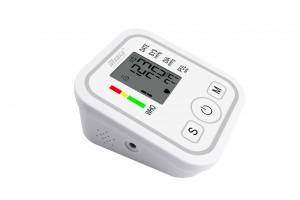How to use sphygmomanometer:
1. Electronic sphygmomanometer
1) Keep the room quiet, and the room temperature should be kept at about 20°C.
2) Before the measurement, the subject should be relaxed. It is best to rest for 20-30 minutes, empty the bladder, refrain from drinking alcohol, coffee or strong tea, and stop smoking.
3) The subject can be in a sitting or supine position, and the tested arm should be placed at the same level as the right atrium (the arm should be at the same level as the fourth costal cartilage when sitting, and at the mid-axillary level when lying), and 45 degrees abduction. Roll up the sleeves to the armpits, or take off one sleeve for easy measurement.
4) Before measuring blood pressure, the gas in the cuff of the sphygmomanometer should be emptied first, and then the cuff should be tied to the upper arm flatly, not too loose or too tight, so as not to affect the accuracy of the measured value. The middle part of the airbag faces the brachial artery of the cubital fossa (most electronic sphygmomanometers mark this position with an arrow on the cuff), and the lower edge of the cuff is 2 to 3 cm from the elbow fossa.
5) Turn on the electronic sphygmomanometer, and record the blood pressure measurement results after the measurement is completed.
6) After the first measurement is completed, the air should be completely deflated. After waiting at least 1 minute, the measurement should be repeated one more time, and the average value of the two times should be taken as the blood pressure value obtained. In addition, if you want to determine whether you are suffering from high blood pressure, it is best to take measurements at different times. It is generally believed that at least three blood pressure measurements at different times can be regarded as high blood pressure.
7) If you need to observe blood pressure changes every day, you should measure the blood pressure of the same arm with the same sphygmomanometer at the same time and in the same position, so that the measured results are more reliable.

2. Mercury sphygmomanometer
1) Observe that the zero position should be 0.5kPa (4mmHg) when not pressurized before use; after pressurization, after 2min without venting, the mercury column should not drop more than 0.5kPa within 1min, and it is forbidden to break the column during pressurization. Or bubbles appear, which will be more obvious at high pressure.
2) First use a balloon to inflate and pressurize the cuff that is tied to the upper arm.
3) When the applied pressure is higher than the systolic pressure, slowly deflate the balloon outwards so that the deflation speed is controlled according to the patient’s pulse rate during the measurement process. For those with a slow heart rate, the speed should be as slow as possible.
4) The stethoscope starts to hear the sound of beating. At this time, the pressure value indicated by the pressure gauge is equivalent to the systolic blood pressure.
5) Continue to deflate slowly.
6) When the stethoscope hears the sound accompanied by the heartbeat, it suddenly weakens or disappears. At this time, the pressure value indicated by the pressure gauge is equivalent to the diastolic blood pressure.
7) To exhaust the air after use, tilt the sphygmomanometer 45° to the right to put the mercury in the mercury pot, and then turn off the mercury switch
Post time: Aug-09-2021

